
US2020: ANOTHER FACEBOOK DISINFORMATION ELECTION?
U.S. flooded with over 158M views of political fake news ahead of the 2020 elections
November 5th, 2019
Download PDF version Back to Disinfo Hub

U.S. flooded with over 158M views of political fake news ahead of the 2020 elections
November 5th, 2019
Download PDF version Back to Disinfo Hub
One year out from the US 2020 elections, a new Avaaz investigation has uncovered a tsunami of political “fake news” flooding US citizens on Facebook. Politically relevant disinformation was found to have reached over 158 million estimated views, enough to reach every reported registered voter1 in the US at least once.
The research team focused on collecting the most viral Facebook posts over a ten-month period, between January 1 and October 31, 2019. Our team then analyzed the top 100 fake news stories about US politics still online on the platform, which, collectively, were posted over 2.3 million times. Avaaz only included examples that had already been fact-checked and debunked by reputable US fact-checking organizations at the time of our study.
The 2016 US elections raised public awareness of disinformation as one of the most serious threats to healthy public discourse, free and fair elections, and democratic stability worldwide. Top Facebook executives, including Mark Zuckerberg, announced immediate action to reduce the spread of harmful disinformation on the platform.2
However, our investigation shows that Facebook’s measures have largely failed to reduce the spread of viral disinformation on the platform. To the contrary, they might have even allowed it to grow: one year before Election Day, the most viral fake news about US politics were able to reach more users than what was reported from three to six months preceding the 2016 elections.3
Without immediate and decisive action, we expect the US 2020 elections to be, once again, severely impacted by disinformation.
One year ahead of the US 2020 elections, the top 100 fact-checked political fake news stories have been posted over 2.3 million times and reached an estimated 158.9 million views and 8.9 million interactions (likes, comments, and shares).
To put this into perspective: Avaaz found enough disinformation to reach each of the 153 million registered voters in the 2018 midterm elections4 once.
The number of views of the 100 fakes across the platform is more than twice the 59.7 million estimated views of the official Facebook pages of the Republican Party (GOP) and the Democratic Party (Democrats)5 in 2019.
The number of views and interactions for the most viral fake news stories spiked in the last 3 months of our research, coinciding with the increased pace of the US 2020 presidential race (August 1 - October 31, 2019):
86 million estimated views of disinformation in the last 3 months, which is more than 3 times as many as during the preceding 3 months (27 million).
When adapting our methodology to only consider the top 20 fake news stories,6 the number of interactions on fake news in the last 3 months - 4.6 million - appears to be 1.5 times more than reported in the period 3 to 6 months before the 2016 elections by the media7 - 3.1 million-.
Negative fake news stories account for 91% of our sample:
62% of the disinformation in our sample were against Democrats/Liberals, reaching over 104 million views out of the 158 million total views.
29% of the disinformation in our sample were against Republicans/ Conservatives, reaching 49 million views.
Only 9% of the disinformation stories in our sample were “positive”. All of them were pro-Republicans/Conservatives, reaching 5 million views.
Most of the fake news sources were individuals (39%) or non-official political pages (35%). Alternative media accounts for 19% of the fakes, politicians for 6%, and mainstream media for 1%.
Some of the most shocking fake news stories analyzed in this report include:
The false claim that Trump’s grandfather was a pimp and tax evader and his father was a member of the KKK (over 29 million estimated views)
The false claim that Nancy Pelosi diverted billions of dollars to cover the costs of the impeachment process (over 24 million estimated views)
The false claim that Democratic Representative Ilhan Oman attended an Al- Qaeda training camp (over 77k estimated views)
The false claim that a Trump supporter was mocking a dead migrant child (over 99k estimated views)
The false claim that Joe Biden called Trump supporters the “Dregs of Society” (over 4 million estimated views)
These findings can only be seen as the tip of the iceberg of disinformation ahead of the US 2020 elections. Avaaz only analyzed the top 100 political fake news on Facebook, that were fact-checked and debunked by reputable US fact-checking organizations. Further analysis into the spread of disinformation on the platform, as well as on YouTube, Twitter, Instagram and WhatsApp should be carried out immediately to reveal more of what lies below the surface of this tidal wave approaching the horizon of the US 2020 elections.
However, the US 2020 elections and other future elections around the world can still be saved from disinformation. To do so, Avaaz is calling on Facebook and all other social media platforms to immediately implement “Correct the Record”, which means working with independent fact- checkers to ensure that EVERY user who has seen or interacted with false information is notified and offered a correction. This solution is proven to work and would tackle disinformation while preserving freedom of expression, as “Correct the Record” provides transparency and facts without deleting any content.
Avaaz’s investigation selected the 100 fake news stories about US politics that had the biggest amount of interactions7 and had already been debunked by major US fact-checking agencies.
Those stories were shared over 2.3 million times on Facebook, and mainly targeted political figures and parties across the political spectrum. Between January 1 and October 31, 2019, they reached over 158.9 million estimated views.
All of the disinformation pieces analyzed in this report have been fact-checked by independent US fact-checking organizations including Snopes, Politifact, FactCheck.org, and Lead Stories.
To understand the scale of the reach of disinformation detailed in this report, in Image 1 we compare the estimated 158,908,992 views of disinformation we found with
153,066,000 registered voters for the 2018 midterms8, meaning we found enough disinformation to reach every registered voter at least once.
59,717,750 estimated views in 20199 for the official Facebook page of the Republican Party (GOP) (2,162,452 likes) and Democratic Party page (Democratic Party) (1,595,689 likes). The disinformation content we found therefore reached more than twice the total number of views of these two pages combined in 20199.
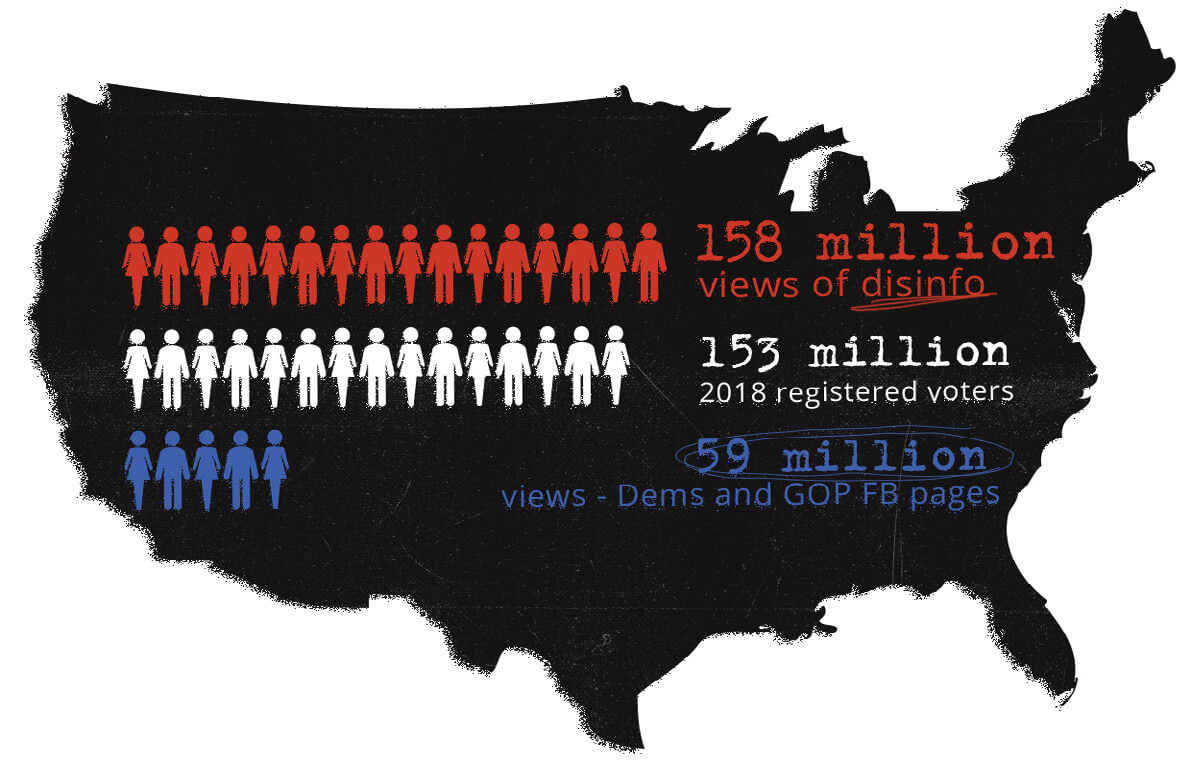
In Image 2, we analyze how much of this disinformation is targeting Democrats/Liberals or Republicans/Conservatives:
62% of political fake news stories in our sample were against Democrats/Liberals, reaching over 104 million views out of the 158 million total views.
29% of political fake news stories in our sample were against Republicans/Conservatives, reaching 49 million views.
9% of political fake news stories were pro Republicans/ Conservatives, reaching 5 million views.
None of political fake news stories were pro Democrats/ Liberals.
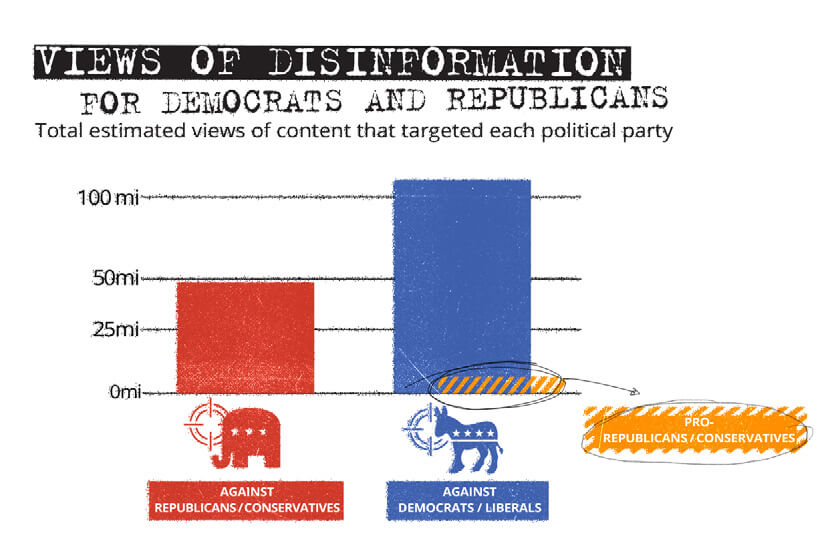
Image 3 shows every fake news item in our database as a circle, labeling in blue those targeting the Democrats, those targeting the Republicans in red, and those that are pro-Republican in orange. The estimated views, the larger the size of the circle.
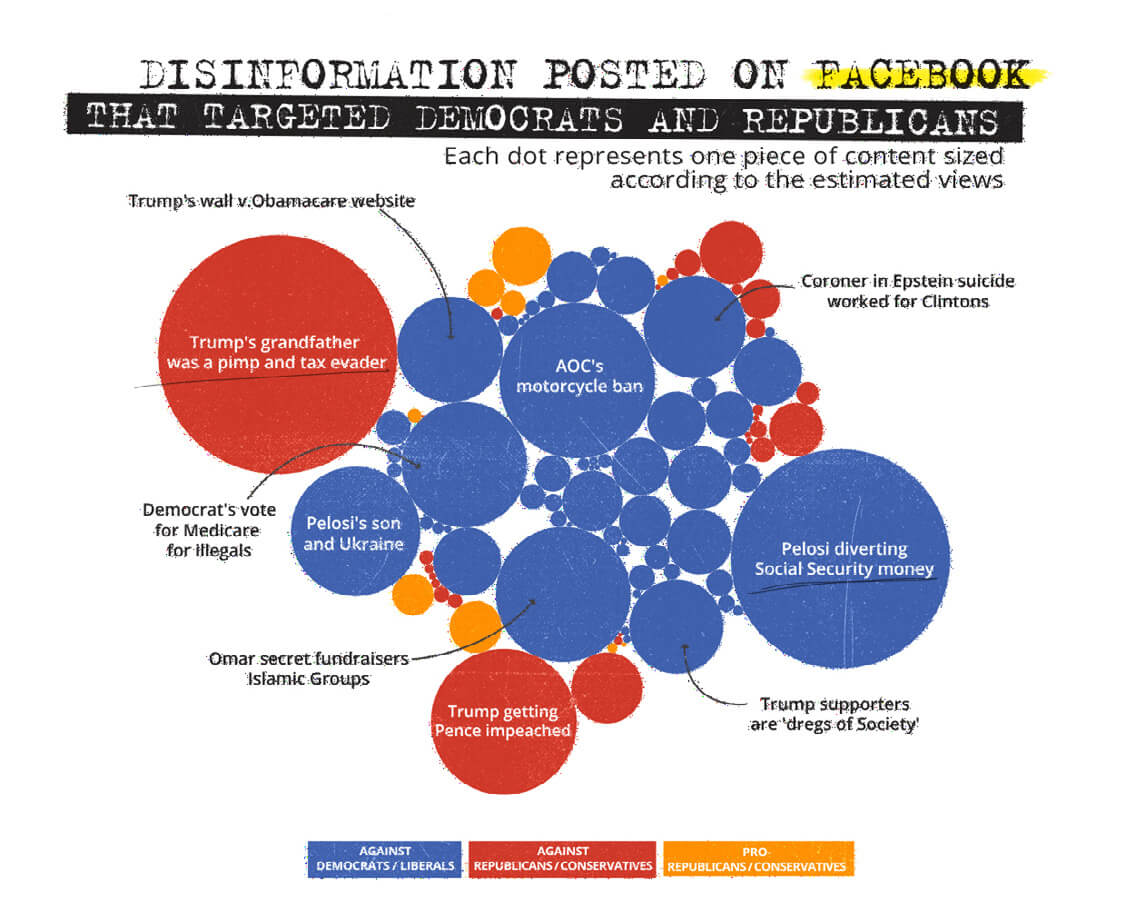
Image 4 shows the main targets of disinformation. Each circle represents the person or group targeted in the post. Circle sizes correspond to the number of times they were targeted. Blue circles are against Democrats/Liberals, red ones against Republicans/Conservatives, orange ones are Pro-Republicans/Conservatives. We found no fake news positively targeting Democratic targets.

In Image 5, we analyze the sources of political disinformation. We identified 5 main categories: political pages (which includes non official partisan pages and activists pages with a clear political position), politicians (when the source was a person affiliated to a political party or an official party page), alternative media, mainstream media and individuals when the source were personal profiles. Individuals and non-official political pages are the biggest sources for sharing or creating the viral fake news in our database.

In Image 6, we break down the sources of disinformation according to the corresponding political targets. While fake news against Democrats/Liberals appear to be mainly driven by political pages (37%), those against Republicans/Conservatives are mainly posted by individuals (62%)
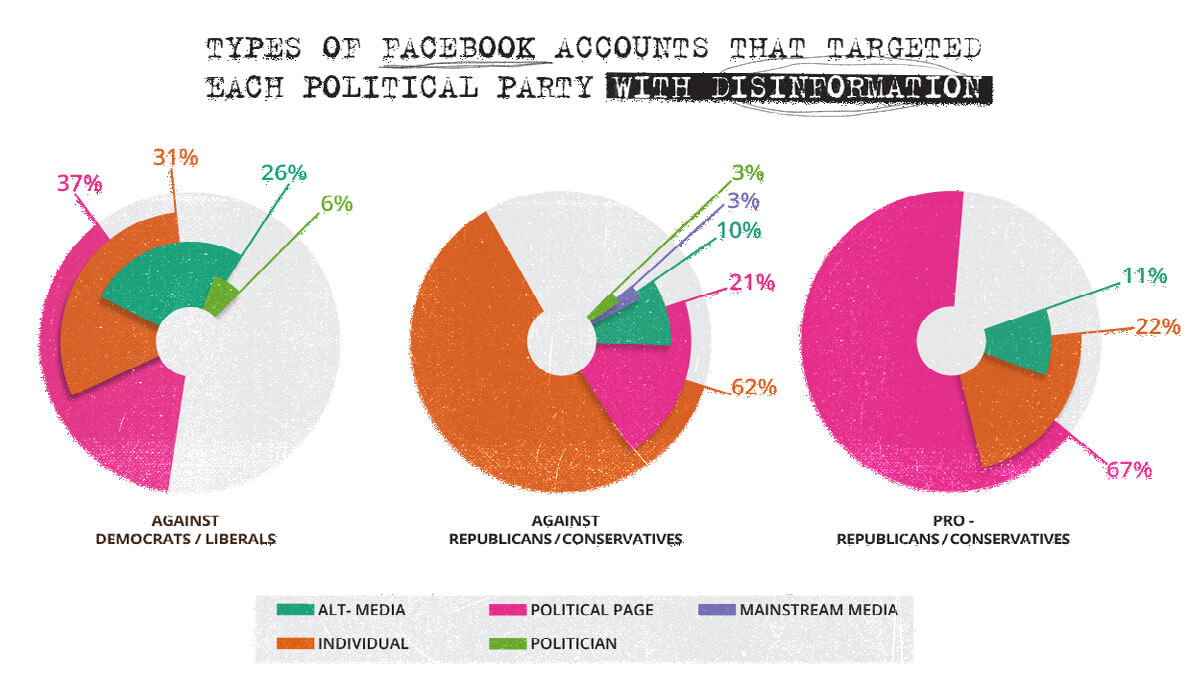
In Image 7, in order to be able to compare our findings with a similar study by Buzzfeed about the 2016 elections10, we apply the same methodology restricting our analysis to the 20 fake news items with the biggest amount of interactions between February and April, May and July, and August and October. This not only shows a spike of disinformation in the last three months, but also that the number of fake news interactions in this timeframe - 4.6 million - appears to be 1.5 times more than Buzzfeed’s analysis identified in the period 3 to 6 months before the 2016 elections11 - 3.1 million. In 2016, Buzzfeed also reported a further spike in the last 3 months before Election Day, with 8.7 million interactions, which highlights the threat we are facing ahead of 2020 elections.
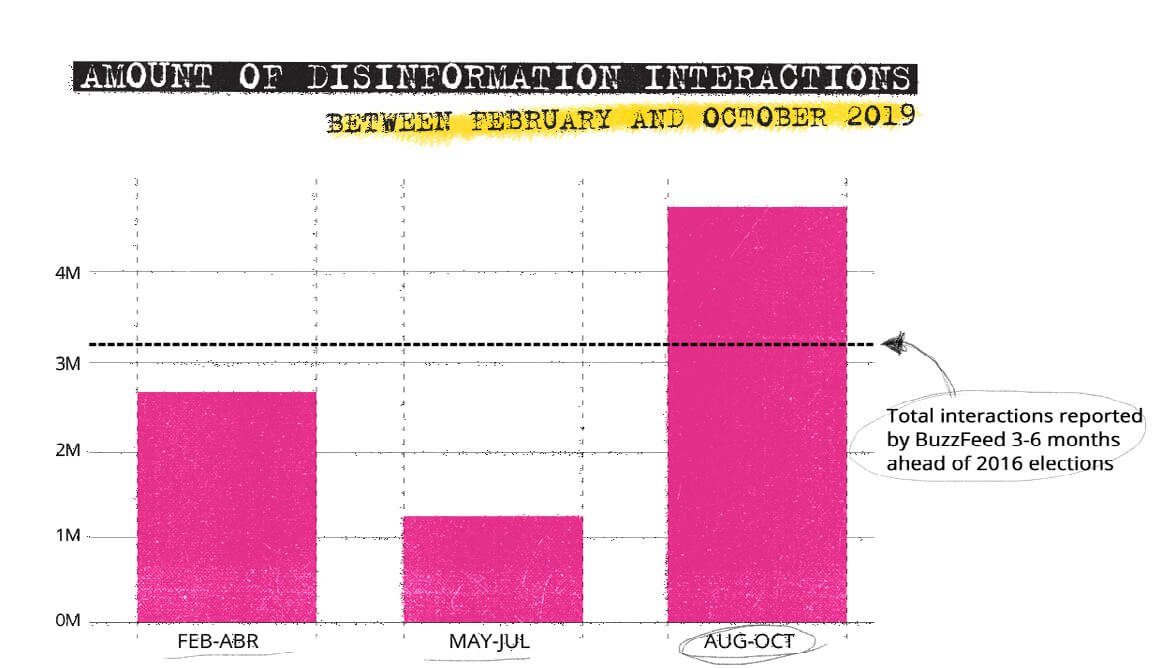
The table below shows the 20 most-viewed fake news stories for the investigation period. The full list of the 100 most viewed fake news can be found in the Annex.
We have provided the post link of the top sharer of each story so it can be viewed in context. For clarity, the “estimated views” and interactions are based on the cumulative CrowdTangle data for each post across the pages, groups and profiles featuring the post on Facebook. The estimates do not represent the views or interactions solely for the account associated with the link provided for each post.
To see all table data, please, scroll to the right.
This chapter presents a selection of some of both the most shared and the most absurd fake news from this investigation - it also shows the breadth of disinformation analyzed in this report. Each item has a summary of the fake news story, its reach, and a short summary from a fact-checking organization debunking the events depicted in the posts.

Disinformation: This post was shared by “ImpeachTrump” on February 18, 2019. The article13, written by the American Herald Tribune in December 2015, asserts that Trump’s grandfather was a pimp and a tax evader, and that his father was a KKK member.
Reach: 29,202,553 estimated views.
Fact check: rated FAKE NEWS by Lead Stories: “Donald’s Trump’s paternal grandfather Frederick Trump accumulated his initial wealth by owning restaurants and hotels in Seattle and the Yukon. [...] Trump’s father Fred Trump was detained at a KKK protest in the Queens borough of New York City, but he was released without charges, according to a New York Times clipping from June 1927. The report did not say he was a member of the KKK and there is no evidence otherwise that he was in the group. As for tax evasion by the grandfather, the article in question offers no details or sourcing.”

Disinformation: The post, shared by an individual in a public group16, claims that Pelosi stole billions of dollars to cover the costs of Donald’s Trump’s impeachment process. The post shared a link to an article from potatriotsunite.com17.
Reach: 24,606,644 estim